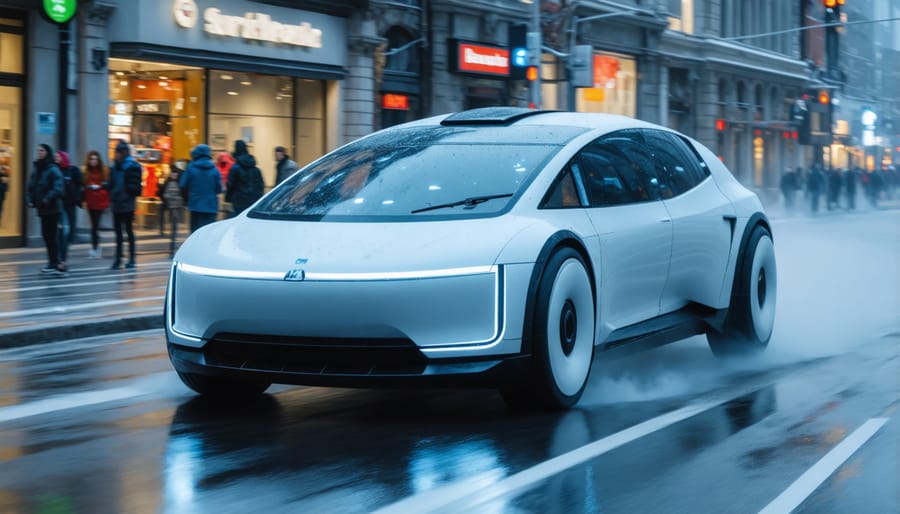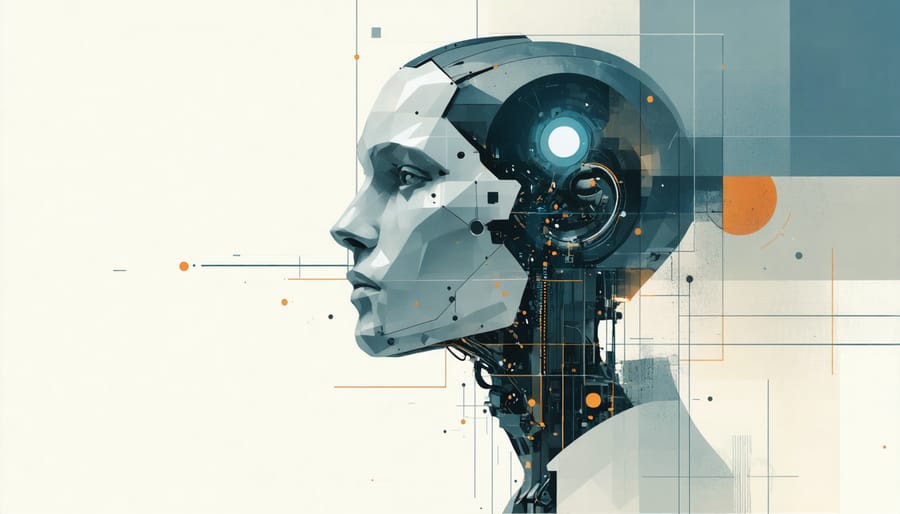In 2018, a self-driving Uber vehicle struck and killed a pedestrian in Arizona, forcing society to confront an unsettling question: who bears responsibility when machines make fatal decisions? This wasn’t a hypothetical trolley problem debated in philosophy classrooms—it was a real tragedy that exposed the vast ethical territory we’re entering as artificial intelligence systems gain the power to act without human oversight.
Autonomous decision-making refers to AI systems that analyze information, evaluate options, and execute actions independently, often faster and more consistently than humans ever could. These systems now approve loans, diagnose diseases, recommend criminal sentences, and control vehicles carrying passengers. Unlike traditional software that follows rigid if-then rules, modern AI learns from data patterns and makes judgment calls in situations its programmers never explicitly anticipated.
The promise is extraordinary: medical AI that catches cancers human eyes miss, traffic systems that eliminate accidents, and hiring algorithms that remove human bias. Yet each application opens troubling questions about fairness, accountability, and control. When an algorithm denies your mortgage application, can you understand why? When autonomous weapons select targets, who answers for civilian casualties? When AI optimizes for efficiency, whose values define what “optimal” means?
These aren’t distant concerns. Autonomous systems already influence whether you get a job interview, what news appears in your feed, and how police patrol your neighborhood. Understanding the ethical implications isn’t just an academic exercise—it’s essential literacy for anyone navigating a world where invisible algorithms increasingly shape human outcomes. This article examines the moral challenges these systems create, the real-world consequences already unfolding, and the frameworks emerging to govern decisions we’re delegating to machines.
What Autonomous Decision-Making Really Means

The Three Levels of Machine Independence
Autonomous decision-making exists on a spectrum, and understanding these levels helps us grasp where human judgment ends and machine control begins.
At the first level, we have assisted decisions, where technology offers suggestions but humans make the final call. Think of your GPS navigation app. It recommends the fastest route to your destination, but you’re free to ignore it and take that scenic backroad instead. The machine provides information; you provide judgment. Your email’s spam filter works similarly—it flags suspicious messages, but you decide whether to delete or retrieve them.
The second level involves automated decisions with oversight. Here, machines make routine choices independently, but humans monitor the process and can intervene when needed. Commercial airplane autopilot exemplifies this perfectly. The system controls altitude, speed, and direction during cruise, handling thousands of micro-adjustments that would exhaust human pilots. However, pilots remain alert, ready to take control during takeoff, landing, or unexpected situations. The machine operates autonomously within defined parameters, with humans serving as the safety net.
The third level represents fully autonomous decisions, where machines operate independently without real-time human supervision. Consider Tesla’s Full Self-Driving technology aspiring toward this goal—a car that theoretically handles every aspect of driving from your driveway to your destination. At this level, the system must anticipate and respond to countless scenarios without human guidance, making split-second ethical and practical decisions that could impact lives.
Each level raises distinct ethical questions about accountability, trust, and the appropriate boundaries of machine authority.
The Ethical Minefield: Where Autonomous Systems Get Stuck
The Accountability Gap: Who Takes the Blame?
When a self-driving car crashes or an AI-powered medical system makes a fatal error, the question becomes painfully urgent: who pays the price? Unlike traditional technology where a human operator makes the final call, autonomous systems operate independently, creating a murky zone of responsibility that our legal and ethical frameworks weren’t designed to handle.
Consider the 2018 case in Tempe, Arizona, where an Uber autonomous vehicle struck and killed a pedestrian. Investigators found the safety driver was distracted, the vehicle’s software failed to properly classify the pedestrian, and Uber had disabled the emergency braking system. Was this the driver’s fault for not intervening? The engineers who programmed inadequate detection algorithms? Uber’s corporate decision to prioritize testing speed over safety? The answer isn’t simple, and this ambiguity reveals a fundamental problem.
Traditional liability models assume clear chains of causation. If a surgeon makes a mistake, they’re responsible. If a car’s brakes fail due to manufacturing defects, the automaker is liable. But autonomous systems involve multiple parties: developers who write the code, companies that deploy it, users who activate it, and the algorithms themselves that learn and adapt in unpredictable ways.
Some propose treating AI systems as legal entities capable of bearing responsibility, similar to how corporations function. Others argue for strict liability, where companies deploying autonomous systems automatically bear responsibility regardless of fault. The European Union’s AI Act takes a risk-based approach, imposing stricter requirements on high-risk applications like healthcare and transportation.
Without clear accountability frameworks, innovation stalls as companies fear unlimited liability, while victims struggle to find recourse. The gap isn’t just legal—it’s ethical, forcing us to reconsider what responsibility means in an age of distributed decision-making.

Bias Baked Into the Code
Artificial intelligence doesn’t wake up one morning and decide to discriminate. Instead, AI systems perpetuate biases by learning from the flawed patterns hidden within their training data. When we feed historical information into these systems, we’re also feeding them decades of human prejudices, structural inequalities, and societal blind spots.
Consider hiring algorithms designed to streamline recruitment. Amazon famously scrapped an AI recruiting tool in 2018 after discovering it systematically downgraded resumes containing the word “women’s” or from graduates of all-women’s colleges. The system had learned from ten years of resumes submitted to the company, predominantly from men in the tech industry. The AI simply concluded that male candidates were preferable because that’s what the historical data suggested.
In the financial sector, loan approval algorithms have repeatedly shown bias against minority applicants. These systems analyze factors like zip codes, employment history, and credit patterns. However, because historical lending practices discriminated against certain communities, those neighborhoods developed different economic patterns. The AI identifies these patterns as risk indicators, creating a self-perpetuating cycle that denies opportunities to already marginalized groups.
Perhaps most troubling are criminal justice tools like COMPAS, which predicts recidivism rates to inform bail and sentencing decisions. Studies revealed the system incorrectly flagged Black defendants as higher risk nearly twice as often as white defendants. The algorithm wasn’t explicitly programmed with racial prejudice, but it absorbed patterns from arrest records shaped by biased policing practices.
These examples reveal an uncomfortable truth: automation doesn’t eliminate human bias. Without careful intervention, it calcifies and scales our worst tendencies under the guise of objective, data-driven decision-making.
The Trolley Problem Goes Digital
Imagine you’re behind the wheel when your brakes suddenly fail. Ahead, five pedestrians cross the street. You can swerve right into a concrete barrier, likely injuring yourself, or continue straight and risk hitting the group. What would you choose? Now, imagine a self-driving car faces this exact scenario. Who decides what it should do?
This modern twist on the classic trolley problem reveals one of the most challenging aspects of moral dilemmas in autonomous vehicles. Unlike philosophical thought experiments, these machines must actually make split-second decisions with real consequences. Should the car prioritize passenger safety above all else? Minimize total casualties? Protect children over adults?
The complexity deepens when we ask who programs these moral frameworks. Engineers aren’t ethicists, yet they’re essentially encoding values into algorithms. Different cultures have varying perspectives on these dilemmas too. A study by MIT found significant global differences in moral preferences, with some cultures prioritizing the young while others value social status differently.
Currently, most autonomous systems are designed to simply avoid accidents altogether through superior reaction times and sensor technology. But edge cases remain where no perfect solution exists. As these vehicles become mainstream, society must grapple with whether we can accept machines making life-and-death decisions, and whose ethical principles they should follow.
Privacy vs. Performance: The Data Dilemma
Autonomous systems face a fundamental challenge: they need vast amounts of data to make accurate decisions, but collecting that data often comes at the cost of personal privacy. Think of it like teaching a child to recognize faces—the more examples they see, the better they get. AI systems work similarly, but instead of a handful of family photos, they require millions of data points about our behaviors, preferences, and movements.
Consider your smartphone’s voice assistant. To understand your requests accurately, it needs to collect voice samples, learn your speech patterns, and sometimes even listen for wake words continuously. Smart home devices monitor your daily routines to optimize heating and lighting. While these systems become more helpful with more data, they’re also building detailed profiles of your private life.
The surveillance aspect becomes more concerning with autonomous vehicles and smart city infrastructure. Self-driving cars equipped with cameras and sensors don’t just map roads—they capture pedestrians, license plates, and building layouts. City-wide traffic management systems track vehicle movements to reduce congestion, but they also create detailed records of where people go and when.
This creates real tension between performance and personal autonomy. Better data privacy and security measures often mean limiting data collection, which can reduce system accuracy. Healthcare AI faces this dilemma acutely—diagnostic algorithms improve with access to patient records, yet those records contain our most sensitive information. Finding the right balance requires transparent data practices, strong encryption, user consent mechanisms, and regulations that protect individuals while enabling beneficial innovation.
Real-World Consequences: When Theory Meets Reality

Healthcare AI: The High Stakes of Diagnosis
In 2016, a deep learning system called DeepMind Health analyzed retinal scans at London’s Moorfields Eye Hospital with remarkable accuracy, detecting over 50 eye diseases as effectively as expert ophthalmologists. This success story represents the promise of healthcare AI—faster diagnoses, reduced human error, and potentially life-saving insights that might slip past even trained eyes.
But the reality is more nuanced. IBM’s Watson for Oncology, once heralded as a breakthrough in cancer treatment, faced scrutiny when doctors discovered it sometimes recommended unsafe and incorrect treatments. In one documented case, it suggested a medication combination that could have caused severe bleeding in a patient with existing conditions. The system had been trained primarily on hypothetical cases rather than real patient outcomes, highlighting a critical vulnerability in medical AI.
The stakes couldn’t be higher. When an autonomous system recommends chemotherapy or advises against surgery, who bears responsibility if something goes wrong? The programmer? The hospital? The AI itself? These questions form the core of healthcare AI ethics.
Consider sepsis detection algorithms now used in hospitals. While some systems successfully identify life-threatening infections hours earlier than human clinicians, others have produced false alarms that lead to unnecessary antibiotic use, contributing to drug resistance. The challenge isn’t just building accurate AI—it’s understanding when to trust it, how to explain its reasoning to patients, and ensuring doctors remain engaged rather than blindly following machine recommendations. Healthcare AI works best as a collaborative tool, not a replacement for human judgment.
Autonomous Vehicles: Testing Ethics on Public Roads
The intersection of autonomous vehicles and real-world consequences became starkly apparent in March 2018, when an Uber self-driving test vehicle struck and killed a pedestrian in Tempe, Arizona. The vehicle’s sensors detected the person crossing the street but classified her inconsistently as an unknown object, then a vehicle, and finally a bicycle. The system ultimately failed to predict her path correctly or brake in time. This tragedy highlighted a critical gap between laboratory testing and unpredictable human behavior on public roads.
Similar incidents have revealed how self-driving systems handle split-second decisions differently than human drivers. In 2016, a Tesla operating on Autopilot failed to distinguish a white semi-trailer against a bright sky, resulting in a fatal collision. The system’s camera-based perception couldn’t process the visual information quickly enough, raising questions about sensor redundancy and fail-safe mechanisms.
These documented cases sparked immediate regulatory responses. The National Transportation Safety Board investigations led to stricter testing protocols and increased transparency requirements for autonomous vehicle companies. California now mandates detailed disengagement reports, showing when human operators must take control. Meanwhile, companies like Waymo and Cruise have implemented additional safety layers, including remote monitoring systems and more conservative decision-making algorithms that prioritize caution over efficiency.
For victims’ families, the aftermath often involves complex legal battles about liability. Is the manufacturer responsible? The software developer? The safety driver? These questions remain largely unresolved, as existing traffic laws weren’t written with artificial intelligence in mind. The incidents serve as sobering reminders that autonomous technology must prove itself significantly safer than human drivers before widespread adoption can be ethically justified.
Building Better Guardrails: Approaches to Ethical Autonomy
Transparency and Explainable AI
As autonomous systems become more integrated into our daily lives, understanding how they make decisions becomes crucial. Imagine receiving a loan rejection without knowing why, or having your job application filtered by AI with no explanation. This lack of transparency creates frustration and erodes trust.
Explainable AI, or XAI, addresses this challenge by making machine learning decisions understandable to humans. Think of it as giving AI systems the ability to show their work, much like a math student explaining how they solved a problem. Instead of treating AI as a “black box” that mysteriously produces answers, XAI techniques reveal the factors influencing each decision.
For example, if an autonomous vehicle suddenly brakes, XAI can explain it detected a pedestrian with 95% confidence based on specific visual patterns. In healthcare, when AI recommends a diagnosis, doctors can see which symptoms and test results carried the most weight in that recommendation.
This transparency is essential for building ethical frameworks for AI and ensuring accountability. When we understand the reasoning behind autonomous decisions, we can identify biases, verify accuracy, and maintain meaningful human oversight over these increasingly powerful systems.
Human-in-the-Loop Systems
Human-in-the-loop systems represent a practical middle ground in autonomous decision-making, where AI handles routine tasks while humans oversee critical choices. Think of it like an airplane’s autopilot: the system manages stable flight conditions, but pilots take control during takeoffs, landings, and emergencies.
This hybrid approach works exceptionally well in healthcare. Medical imaging AI can flag potential tumors in thousands of scans, but a radiologist makes the final diagnosis. The AI accelerates the process, yet human expertise catches nuances the algorithm might miss and considers the patient’s complete medical history.
Similarly, content moderation platforms use AI to filter obvious policy violations across millions of posts daily, while human moderators review borderline cases involving cultural context or satire. The system scales efficiently without sacrificing judgment quality.
However, full autonomy remains necessary in time-sensitive scenarios. Self-driving cars must react to sudden obstacles in milliseconds—too fast for human intervention. Fraud detection systems need to block suspicious transactions instantly to prevent financial loss.
The key is identifying which decisions benefit from human wisdom, empathy, and accountability versus those requiring split-second responses. As these systems evolve, the challenge lies in designing seamless handoffs between human and machine, ensuring each contributes their unique strengths to create more reliable, ethical outcomes.

Regulation and Industry Standards
As autonomous systems become more prevalent in healthcare, finance, and transportation, governments and organizations worldwide are racing to establish guardrails. The European Union leads with its AI Act, which classifies AI systems by risk level and imposes strict requirements on high-risk applications like autonomous medical diagnosis or credit scoring. Meanwhile, the United States takes a more sector-specific approach, with agencies like the FDA regulating autonomous medical devices and the Department of Transportation overseeing self-driving vehicles.
Industry leaders aren’t waiting for mandates. Major tech companies have formed partnerships like the Partnership on AI, creating voluntary ethical frameworks that emphasize transparency, accountability, and human oversight. These self-governance initiatives address real concerns: when an autonomous hiring system discriminates or a self-driving car causes an accident, who’s responsible? Progressive companies now conduct regular audits of their decision-making algorithms and publish transparency reports showing how their systems work. However, critics argue that voluntary standards lack teeth without enforcement mechanisms. The challenge ahead is balancing innovation with protection, ensuring autonomous systems serve humanity rather than operating in an ethical vacuum.
As we navigate the complex landscape of autonomous decision-making, one truth becomes clear: the ethical considerations surrounding these systems aren’t optional add-ons—they’re fundamental requirements. The tensions we’ve explored between efficiency and fairness, transparency and proprietary interests, and individual convenience versus collective wellbeing won’t resolve themselves. Instead, they demand our active participation in shaping how these technologies evolve.
Think about the autonomous systems you encounter daily. Your social media feed curating content, navigation apps choosing your route, or automated customer service responding to your questions. Each represents a small delegation of decision-making power to an algorithm. By understanding the ethical implications behind these systems, you’re better equipped to question their recommendations, recognize their limitations, and advocate for more responsible design.
The path forward requires embedding ethical frameworks into the earliest stages of technology development, not as afterthoughts during deployment. This means diverse teams considering multiple perspectives, transparent testing processes that reveal potential biases, and accountability structures that assign clear responsibility when systems fail. Companies developing autonomous technologies must move beyond asking “can we build this?” to “should we build this, and how can we build it responsibly?”
Your role in this future matters more than you might think. By asking questions about the autonomous systems you use, supporting companies that prioritize ethical AI development, and staying informed about emerging technologies, you contribute to a collective demand for responsible innovation. The autonomous future isn’t predetermined—it’s being written right now, and you have a voice in how that story unfolds. The technology we create today will reflect the values we choose to prioritize, so let’s ensure those values include fairness, transparency, and human dignity.

